

Compact Muon Solenoid
LHC, CERN
| CMS-HIN-14-008 ; CERN-EP-2016-042 | ||
| Pseudorapidity dependence of long-range two-particle correlations in pPb collisions at $\sqrt{\smash[b]{s_{_{\mathrm{NN}}}}} = $ 5.02 TeV | ||
| CMS Collaboration | ||
| 18 April 2016 | ||
| Phys. Rev. C 96 (2017) 014915 | ||
| Abstract: Two-particle correlations in pPb collisions at a nucleon-nucleon center-of-mass energy of 5.02 TeV are studied as a function of the pseudorapidity separation ($\Delta \eta$) of the particle pair at small relative azimuthal angle ($| \Delta \phi | < \pi/3$). The correlations are decomposed into a jet component that dominates the short-range correlations ($ | \Delta \eta | < $ 1), and a component that persists at large $\Delta \eta$ and may originate from collective behavior of the produced system. The events are classified in terms of the multiplicity of the produced particles. Finite azimuthal anisotropies are observed in high-multiplicity events. The second and third Fourier components of the particle-pair azimuthal correlations, $V_2$ and $V_3$, are extracted after subtraction of the jet component. The single-particle anisotropy parameters $v_2$ and $v_3$ are normalized by their lab frame mid-rapidity value and are studied as a function of $\eta_{\text{cm}}$. The normalized $v_2$ distribution is found to be asymmetric about $\eta_{\text{cm}} = $ 0, with smaller values observed at forward pseudorapidity, corresponding to the direction of the proton beam, while no significant pseudorapidity dependence is observed for the normalized $v_3$ distribution within the statistical uncertainties. | ||
| Links: e-print arXiv:1604.05347 [nucl-ex] (PDF) ; CDS record ; inSPIRE record ; CADI line (restricted) ; | ||
| Figures | |
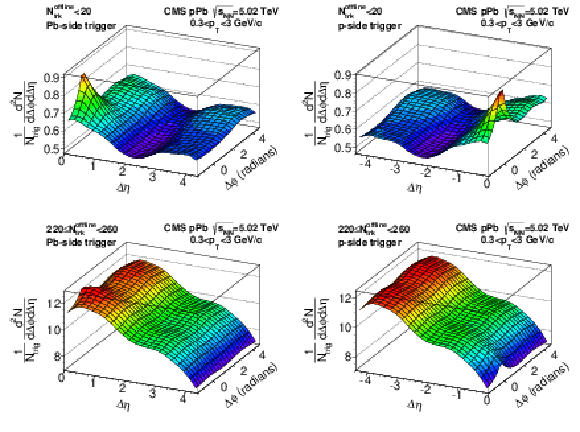
png pdf |
Figure 1:
Efficiency-corrected 2D associated yields with Pb-side trigger particle ($-2.4 < {\eta _\text {lab}^{\text {trig}}} < -2.0$, left panels) and p-side trigger particle (2.0 $ < {\eta _\text {lab}^{\text {trig}}} < $ 2.4, right panels) in low-multiplicity (2 $ \leq {N_\text {trk}^\text {offline}} < $ 20, upper panels) and high-multiplicity (220 $ \leq {N_\text {trk}^\text {offline}} < $ 260, lower panels) are shown for pPb collisions at $ {\sqrt {\smash [b]{s_{_{NN}}}}} = $ 5.02 TeV. The associated and trigger particle $ {p_{\mathrm {T}}} $ ranges are both 0.3 $ < {p_{\mathrm {T}}} < $ 3 GeV/$c$. |
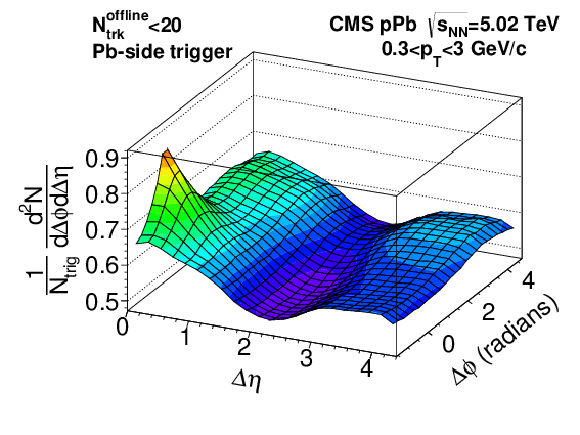
png pdf |
Figure 1-a:
Efficiency-corrected 2D associated yields with Pb-side trigger particle ($-2.4 < {\eta _\text {lab}^{\text {trig}}} < -2.0$) in low-multiplicity (2 $ \leq {N_\text {trk}^\text {offline}} < $ 20) and are shown for pPb collisions at $ {\sqrt {\smash [b]{s_{_{NN}}}}} = $ 5.02 TeV. The associated and trigger particle $ {p_{\mathrm {T}}} $ ranges are both 0.3 $ < {p_{\mathrm {T}}} < $ 3 GeV/$c$. |
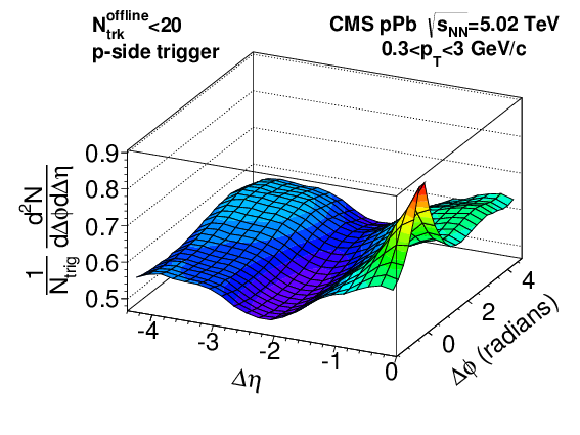
png pdf |
Figure 1-b:
Efficiency-corrected 2D associated yields with p-side trigger particle (2.0 $ < {\eta _\text {lab}^{\text {trig}}} < $ 2.4) in low-multiplicity (2 $ \leq {N_\text {trk}^\text {offline}} < $ 20) and are shown for pPb collisions at $ {\sqrt {\smash [b]{s_{_{NN}}}}} = $ 5.02 TeV. The associated and trigger particle $ {p_{\mathrm {T}}} $ ranges are both 0.3 $ < {p_{\mathrm {T}}} < $ 3 GeV/$c$. |
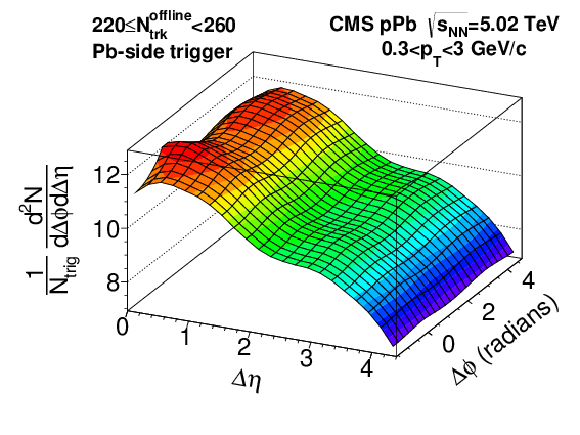
png pdf |
Figure 1-c:
Efficiency-corrected 2D associated yields with Pb-side trigger particle ($-2.4 < {\eta _\text {lab}^{\text {trig}}} < -2.0$) in high-multiplicity (220 $ \leq {N_\text {trk}^\text {offline}} < $ 260) are shown for pPb collisions at $ {\sqrt {\smash [b]{s_{_{NN}}}}} = $ 5.02 TeV. The associated and trigger particle $ {p_{\mathrm {T}}} $ ranges are both 0.3 $ < {p_{\mathrm {T}}} < $ 3 GeV/$c$. |

png pdf |
Figure 1-d:
Efficiency-corrected 2D associated yields with p-side trigger particle (2.0 $ < {\eta _\text {lab}^{\text {trig}}} < $ 2.4) in high-multiplicity (220 $ \leq {N_\text {trk}^\text {offline}} < $ 260) are shown for pPb collisions at $ {\sqrt {\smash [b]{s_{_{NN}}}}} = $ 5.02 TeV. The associated and trigger particle $ {p_{\mathrm {T}}} $ ranges are both 0.3 $ < {p_{\mathrm {T}}} < $ 3 GeV/$c$. |
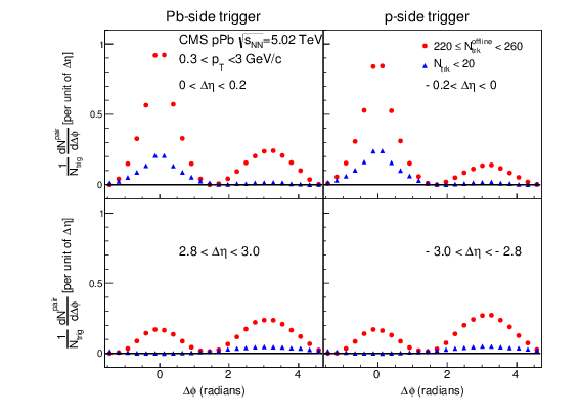
png pdf |
Figure 2:
Examples of the distribution of the associated yields after ZYAM subtraction for both low-multiplicity (2 $ \leq {N_\text {trk}^\text {offline}} < $ 20, blue triangles) and high-multiplicity (220 $ \leq {N_\text {trk}^\text {offline}} < $ 260, red circles) are shown for pPb collisions at $ {\sqrt {\smash [b]{s_{_{NN}}}}} = $ 5.02 TeV. The results for Pb-side (left panels) and p-side (right panels) trigger particles are both shown; small $ {\Delta \eta} $ in the upper panels and large $ {| {\Delta \eta} |}$ in the lower panels. The trigger and associated particle $ {p_{\mathrm {T}}} $ ranges are both 0.3 $ < {p_{\mathrm {T}}} < $ 3 GeV/$c$. |

png pdf |
Figure 3:
The near-side ($| {\Delta \phi} | < \pi /3$) correlated yield after ZYAM subtraction in low-multiplicity 2 $ \leq {N_\text {trk}^\text {offline}} < $ 20 (upper panels) and high-multiplicity 220 $ \leq {N_\text {trk}^\text {offline}} < $ 260 (lower panels) are shown for pPb collisions at $ {\sqrt {\smash [b]{s_{_{NN}}}}} = $ 5.02 TeV. The trigger and associated particle $ {p_{\mathrm {T}}} $ ranges are both 0.3 $ < {p_{\mathrm {T}}} < $ 3 GeV/$c$. The trigger particles are restricted to the Pb-side ($-2.4 < {\eta _\text {lab}^{\text {trig}}} < -2.0$, left panels) and the p-side (2.0 $ < {\eta _\text {lab}^{\text {trig}}} < $ 2.4, right panels), respectively. Fit results using Eq.(1) (black solid curves) are superimposed; the red dashed curve and the blue open points are the two fit components, jet and ridge, respectively. |

png pdf |
Figure 4:
Fourier coefficients, $V_2$ (upper) and $V_3$ (lower), of two-particle azimuthal correlations in high-multiplicity collisions (220 $ \leq {N_\text {trk}^\text {offline}} < $ 260) with (circles) and without (triangles) subtraction of low-multiplicity data, as a function of $ {\eta _{\text {lab}}} $. Left panel shows data for Pb-side trigger particles and the right panel for the p-side. Statistical uncertainties are mostly smaller than point size; systematic uncertainties are 3.9% and 10% for $V_2$ and $V_3$ without low-multiplicity subtraction, 5.8% and 15% for $V_2$ and $V_3$ with low-multiplicity subtraction, respectively. The systematic uncertainties are shown by the shaded bands. |
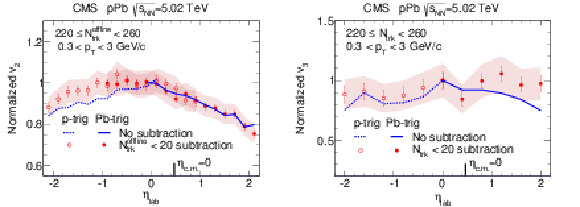
png pdf |
Figure 5:
Self-normalized anisotropy parameters, $v_2({\eta _{\text {lab}}})/v_2({\eta _{\text {lab}}} =0)$ (left panel) and $v_3({\eta _{\text {lab}}})/v_3({\eta _{\text {lab}}} =0)$ (right panel), as a function of $ {\eta _{\text {lab}}} $. Data points (curves) are results with (without) low-multiplicity data subtraction; filled circles and solid lines are from the Pb-side trigger. Open circles and dashed lines are from the p-side trigger. The bands show systematic uncertainties of $ \pm $5.7% and $ \pm $14% for $v_2({\eta _{\text {lab}}})/v_2({\eta _{\text {lab}}} =0)$ and $v_3({\eta _{\text {lab}}})/v_3({\eta _{\text {lab}}} =0)$, respectively. The systematic uncertainties in $v_n({\eta _{\text {lab}}})/v_n({\eta _{\text {lab}}} =0)$ without subtraction are similar. Error bars indicate statistical uncertainties only. |
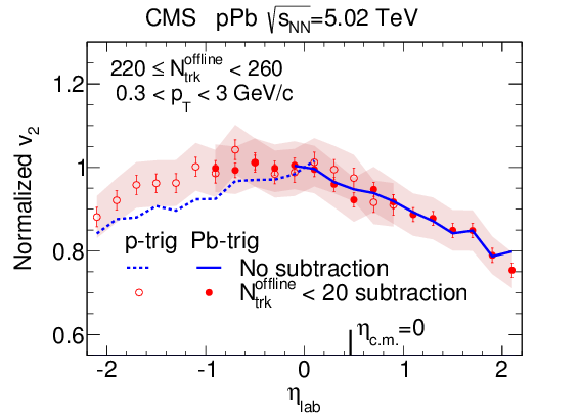
png pdf |
Figure 5-a:
Self-normalized anisotropy parameter $v_2({\eta _{\text {lab}}})/v_2({\eta _{\text {lab}}} =0)$ as a function of $ {\eta _{\text {lab}}} $. Data points (curves) are results with (without) low-multiplicity data subtraction; filled circles and solid lines are from the Pb-side trigger. Open circles and dashed lines are from the p-side trigger. The bands show systematic uncertainties of $ \pm $5.7% for $v_2({\eta _{\text {lab}}})/v_2({\eta _{\text {lab}}} =0)$. Error bars indicate statistical uncertainties only. |
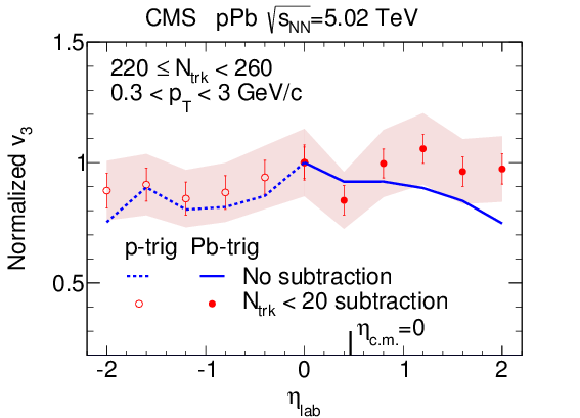
png pdf |
Figure 5-b:
Self-normalized anisotropy parameter $v_3({\eta _{\text {lab}}})/v_3({\eta _{\text {lab}}} =0)$ as a function of $ {\eta _{\text {lab}}} $. Data points (curves) are results with (without) low-multiplicity data subtraction; filled circles and solid lines are from the Pb-side trigger. Open circles and dashed lines are from the p-side trigger. The bands show systematic uncertainties of $ \pm $14% for $v_3({\eta _{\text {lab}}})/v_3({\eta _{\text {lab}}} =0)$. Error bars indicate statistical uncertainties only. |

png pdf |
Figure 6:
$v_2({\eta _{\text {c.m.}}})/v_2(- {\eta _{\text {c.m.}}})$, as a function of $ {\eta _{\text {c.m.}}} $ in the center-of-mass frame. The data points are results from $V_n^\text {sub}$ with low-multiplicity data subtracted. The bands show the systematic uncertainty of $\pm $5.7%. Error bars indicate statistical uncertainties only. |
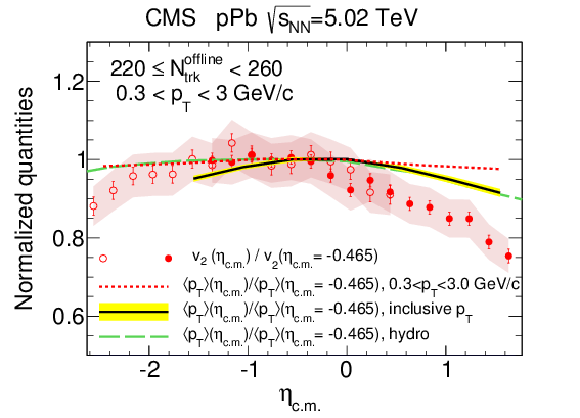
png pdf |
Figure 7:
Self-normalized $v_2({\eta _{\text {c.m.}}})/v_2({\eta _{\text {c.m.}}} =-0.465)$ distribution with low-multiplicity subtraction from Pb-side (filled circles) and p-side (open circles) triggers, and $ < {p_{\mathrm {T}}} > ({\eta _{\text {c.m.}}})/< {p_{\mathrm {T}}} > ({\eta _{\text {c.m.}}} = - 0.465)$ of 0 $ < {p_{\mathrm {T}}} < $ 6 GeV/$c$ range from minimum-bias events (solid line) and 0.3 $ < {p_{\mathrm {T}}} < $ 3 GeV/$c$ range from high-multiplicity (220 $ \leq {N_\text {trk}^\text {offline}} < $ 260) events (dotted line) as functions of $ {\eta _{\text {c.m.}}} $. Dashed curve is the hydrodynamic prediction for $< {p_{\mathrm {T}}} > ({\eta _{\text {c.m.}}})/< {p_{\mathrm {T}}} > ({\eta _{\text {c.m.}}} = -0.465)$ distribution. |
| Tables | |
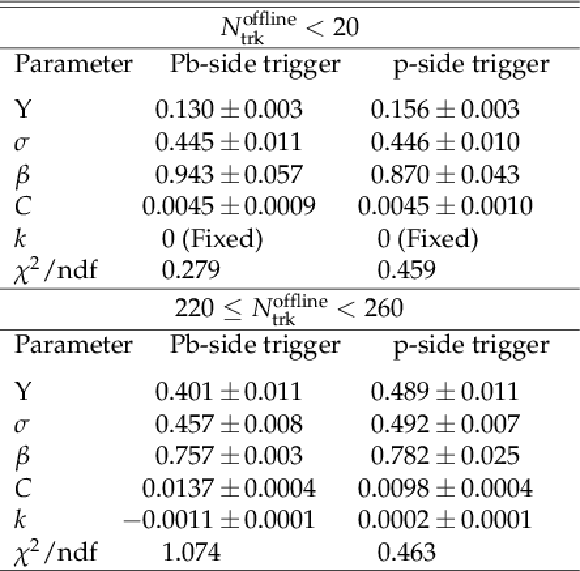
png pdf |
Table 1:
Summary of fit parameters for low- and high-$ {N_\text {trk}^\text {offline}} $ ranges in pPb collisions. |

png pdf |
Table 2:
Summary of systematic uncertainties in the second and third Fourier harmonics in pPb collisions. The label "low-mult sub'' indicates the low-multiplicity subtracted results, while "no sub" indicates the results without subtraction. |
| Summary |
|
Two-particle correlations as functions of $\Delta \phi$ and $\Delta \eta$ are reported in pPb\ collisions at $\sqrt{\smash[b]{s_{_{\mathrm{NN}}}}} = 5.02$ TeV by the CMS experiment. The trigger particle is restricted to narrow pseudorapidity windows. The combinatorial background is assumed to be uniform in $\Delta \phi$ and normalized by the ZYAM procedure as a function of $\Delta \eta$. The near-side jet correlated yield is fitted and found to be greater in high-multiplicity than in low-multiplicity collisions. The ridge yield is studied as a function of $\Delta \phi$ and $\Delta \eta$ and it is found to depend on pseudorapidity and the underlying background shape ZYAM($\Delta \eta$). The pseudorapidity dependence differs for trigger particles selected on the proton and the Pb sides. The Fourier coefficients of the two-particle correlations in high-multiplicity collisions are reported, with and without subtraction of the scaled low-multiplicity data. The pseudorapidity dependence of the single-particle anisotropy parameters, $v_2$ and $v_3$, is inferred. Significant pseudorapidity dependence of $v_2$ is found. The distribution is asymmetric about $\eta_{\text{cm}} = $ 0 with an approximate (20 $\pm$ 4 )% decrease from $\eta_{\text{cm}} = $ 0 to $\eta_{\text{cm}}\approx $ 1.5, and a smaller decrease towards the Pb-beam direction. Finite $v_3$ is observed, but the uncertainties are presently too large to draw conclusions regarding the pseudorapidity dependence. The self-normalized $v_2(\eta_{\text{cm}})/v_2(\eta_{\text{cm}}=-0.465)$ distribution is compared to the $ < {p_{\mathrm{T}}} > (\eta_{\text{cm}})/ < {p_{\mathrm{T}}} > (\eta_{\text{cm}}= -0.465)$ distribution as well as from hydrodynamic calculations. The $ < {p_{\mathrm{T}}} > (\eta_{\text{cm}})/ < {p_{\mathrm{T}}} > (\eta_{\text{cm}}= -0.465)$ distribution shows a decreasing trend towards positive $\eta_{\text{cm}}$. The $v_2(\eta_{\text{cm}})/v_2(\eta_{\text{cm}} = -0.465)$ distribution also shows a decreasing trend towards positive $\eta_{\text{cm}}$, but the decrease is more significant in the case of the $v_2$ measurement. This indicates that physics mechanisms other than the change in the underlying particle spectra, such as event plane decorrelation over pseudorapidity, may influence the anisotropic flow. |
| References | ||||
| 1 | STAR Collaboration | Experimental and theoretical challenges in the search for the quark gluon plasma: The STAR Collaboration's critical assessment of the evidence from RHIC collisions | NP A 757 (2005) 102 | nucl-ex/0501009 |
| 2 | PHENIX Collaboration | Formation of dense partonic matter in relativistic nucleus-nucleus collisions at RHIC: Experimental evaluation by the PHENIX collaboration | NP A 757 (2005) 184 | nucl-ex/0410003 |
| 3 | PHOBOS Collaboration | The PHOBOS perspective on discoveries at RHIC | NP 757 (2005) 28 | nucl-ex/0410022 |
| 4 | STAR Collaboration | Distributions of charged hadrons associated with high transverse momentum particles in pp and Au+Au collisions at $ \sqrt{s_{NN}} = $ 200 GeV | PRL 95 (2005) 152301 | nucl-ex/0501016 |
| 5 | PHOBOS Collaboration | High transverse momentum triggered correlations over a large pseudorapidity acceptance in Au+Au collisions at $ \sqrt{s_{NN}}= $ 200 GeV | PRL 104 (2010) 062301 | 0903.2811 |
| 6 | STAR Collaboration | Long range rapidity correlations and jet production in high energy nuclear collisions | PRC 80 (2009) 064912 | 0909.0191 |
| 7 | STAR Collaboration | Three-particle coincidence of the long range pseudorapidity correlation in high energy nucleus-nucleus collisions | PRL 105 (2010) 022301 | 0912.3977 |
| 8 | CMS Collaboration | Centrality dependence of dihadron correlations and azimuthal anisotropy harmonics in PbPb collisions at $ \sqrt{s_{NN}}= $ 2.76 TeV | EPJC 72 (2012) 2012 | CMS-HIN-11-006 1201.3158 |
| 9 | CMS Collaboration | Observation of long-range near-side angular correlations in proton-proton collisions at the LHC | JHEP 09 (2010) 091 | CMS-QCD-10-002 1009.4122 |
| 10 | CMS Collaboration | Observation of long-range near-side angular correlations in proton-lead collisions at the LHC | PLB 718 (2013) 795 | CMS-HIN-12-015 1210.5482 |
| 11 | ALICE Collaboration | Long-range angular correlations on the near and away side in $ p $-Pb collisions at $ \sqrt{s_{NN}} = $ 5.02 TeV | PLB 719 (2013) 29 | 1212.2001 |
| 12 | ATLAS Collaboration | Observation of Associated Near-side and Away-side Long-range Correlations in $ \sqrt{s_{NN}} = $ 5.02 TeV Proton-lead Collisions with the ATLAS Detector | PRL 110 (2013) 182302 | 1212.5198 |
| 13 | PHENIX Collaboration | Measurement of long-range angular correlation and quadrupole anisotropy of pions and (anti)protons in central d+Au collisions at $ \sqrt{s_{NN}} = $ 200 GeV | PRL 114 (2015) 192301 | |
| 14 | STAR Collaboration | Long-range pseudorapidity dihadron correlations in d+Au collisions at $ \sqrt{s_{NN}}= $ 200 GeV | PLB 747 (2015) 265 | |
| 15 | PHENIX Collaboration | Measurements of elliptic and triangular flow in high-multiplicity $ ^{3} $He$ + $Au collisions at $ \sqrt{s_{_{NN}}}= $ 200 GeV | PRL 115 (2015), no. 14, 142301 | 1507.06273 |
| 16 | J.-Y. Ollitrault | Anisotropy as a signature of transverse collective flow | PRD 46 (1992) 229 | |
| 17 | R. Andrade et al. | Examining the necessity to include event-by-event fluctuations in experimental evaluations of elliptical flow | PRL 97 (2006) 202302 | nucl-th/0608067 |
| 18 | B. Alver and G. Roland | Collision geometry fluctuations and triangular flow in heavy-ion collisions | PRC 81 (2010) 054905 | 1003.0194 |
| 19 | C. Gale, S. Jeon, and B. Schenke | Hydrodynamic modeling of heavy-ion collisions | Int. J. Mod. Phys. A 28 (2013) 1340011 | 1301.5893 |
| 20 | U. Heinz and R. Snellings | Collective flow and viscosity in relativistic heavy-ion collisions | Ann. Rev. Nucl. Part. Sci. 63 (2013) 123 | 1301.2826 |
| 21 | L. He et al. | Anisotropic parton escape is the dominant source of azimuthal anisotropy in transport models | PLB 753 (2016) 506 | 1502.05572 |
| 22 | A. Dumitru et al. | The Ridge in proton-proton collisions at the LHC | PLB 697 (2011) 21 | 1009.5295 |
| 23 | K. Dusling and R. Venugopalan | Comparison of the color glass condensate to di-hadron correlations in proton-proton and proton-nucleus collisions | PRD 87 (2013) 094034 | 1302.7018 |
| 24 | S. Gavin, L. McLerran, and G. Moschelli | Long Range Correlations and the Soft Ridge in Relativistic Nuclear Collisions | PRC 79 (2009) 051902 | 0806.4718 |
| 25 | K. Dusling and R. Venugopalan | Azimuthal collimation of long range rapidity correlations by strong color fields in high multiplicity hadron-hadron collisions | PRL 108 (2012) 262001 | 1201.2658 |
| 26 | CMS Collaboration | Measurement of long-range near-side two-particle angular correlations in $ pp $ collisions at $ \sqrt{s}=13\text{} $ TeV | PRL 116 (Apr, 2016) 172302 | |
| 27 | ATLAS Collaboration | Observation of long-range elliptic azimuthal anisotropies in $ \sqrt{s}= $ 13 and 2.76 $ TeV pp $ collisions with the ATLAS detector | PRL 116 (2015) 172301 | 1509.04776 |
| 28 | ALICE Collaboration | Forward-central two-particle correlations in p-pb collisions at $ \sqrt{s_{NN}} = $ 5.02 TeV | Physics Letters B 753 (2016) 126 | |
| 29 | CMS Collaboration | Multiplicity and transverse momentum dependence of two- and four-particle correlations in pPb and PbPb collisions | PLB 724 (2013) 213 | CMS-HIN-13-002 1305.0609 |
| 30 | ATLAS Collaboration | Measurement with the ATLAS detector of multi-particle azimuthal correlations in p+Pb collisions at $ \sqrt{s_{NN}} = $ 5.02 TeV | PLB 725 (2013) 60 | |
| 31 | CMS Collaboration | Evidence for collective multi-particle correlations in pPb collisions | PRL 115 (2015) 012301 | |
| 32 | P. Bo\.ek | Collective flow in $ p $-pb and $ d $-pb collisions at tev energies | PRC 85 (2012) 014911 | |
| 33 | CMS Collaboration | Long-range two-particle correlations of strange hadrons with charged particles in pPb and PbPb collisions at LHC energies | PLB 742 (2015) 200 | |
| 34 | ALICE Collaboration | Long-range angular correlations of $ \pi $, k, and p in p-pb collisions at $ \sqrt{s_{NN}} = $ 5.02 tev | PLB 726 (2013) 164 | |
| 35 | P. Bozek | Elliptic flow in proton-proton collisions at $ \sqrt{s_{\rm NN}} = $ 7 TeV | EPJC 71 (2011) 1530 | 1010.0405 |
| 36 | P. Bozek and W. Broniowski | Correlations from hydrodynamic flow in p-Pb collisions | PLB 718 (2013) 1557 | 1211.0845 |
| 37 | P. Bozek, A. Bzdak, and V. Skokov | The rapidity dependence of the average transverse momentum in p+Pb collisions at the LHC: the Color Glass Condensate versus hydrodynamics | PLB 728 (2014) 662 | |
| 38 | F. O. Dur\ aes, A. V. Giannini, V. P. Goncalves, and F. S. Navarra | Rapidity dependence of the average transverse momentum in hadronic collisions | PRC 94 (2016) 024917 | 1510.04737 |
| 39 | T. Pierog et al. | EPOS LHC: Test of collective hadronization with data measured at the CERN Large Hadron Collider | PRC 92 (2015) 034906 | 1306.0121 |
| 40 | P. Bozek, A. Bzdak, and G. Ma | Rapidity dependence of elliptic and triangular flow in proton-nucleus collisions from collective dynamics | PLB 748 (2015) 301 | |
| 41 | P. Bo\.zek, W. Broniowski, and J. Moreira | Torqued fireballs in relativistic heavy-ion collisions | PRC 83 (2011) 034911 | |
| 42 | K. Xiao, F. Liu, and F. Wang | Event-plane decorrelation over pseudorapidity and its effect on azimuthal anisotropy measurements in relativistic heavy-ion collisions | PRC 87 (2013) 011901 | |
| 43 | L.-G. Pang et al. | Longitudinal decorrelation of anisotropic flows in heavy-ion collisions at the CERN Large Hadron Collider | PRC 91 (2015) 044904 | |
| 44 | CMS Collaboration | Evidence for transverse-momentum- and pseudorapidity- dependent event-plane fluctuations in PbPb and $ p $Pb collisions | PRC 92 (2015) 034911 | nucl-ex/1503.01692 |
| 45 | CMS Collaboration | Long-range and short-range dihadron angular correlations in central PbPb collisions at a nucleon-nucleon center of mass energy of 2.76 TeV | JHEP 07 (2011) 076 | CMS-HIN-11-001 1105.2438 |
| 46 | L. Xu, C.-H. Chen, and F. Wang | Event mixing does not reproduce single particle acceptance convolutions for nonuniform pseudorapidity distributions | PRC 88 (2013) 064907 | 1304.8120 |
| 47 | ALICE Collaboration | Harmonic decomposition of two-particle angular correlations in Pb-Pb collisions at $ \sqrt{s_{_{NN}}} = $ 2.76 TeV | PLB 708 (2012) 249 | 1109.2501 |
| 48 | CMS Collaboration | The CMS experiment at the CERN LHC | JINST 3 (2008) S08004 | CMS-00-001 |
| 49 | Geant4 Collaboration | GEANT4 --- a simulation toolkit | NIMA 506 (2003) 250 | |
| 50 | CMS Collaboration | Luminosity calibration for the 2013 proton-lead and proton-proton data taking | CMS-PAS-LUM-13-002 | CMS-PAS-LUM-13-002 |
| 51 | CMS Collaboration | Tracking and vertexing results from first collisions | CDS | |
| 52 | M. Gyulassy and X.-N. Wang | HIJING 1.0: A Monte Carlo program for parton and particle production in high-energy hadronic and nuclear collisions | CPC 83 (1994) 307 | nucl-th/9502021 |
| 53 | S. Porteboeuf, T. Pierog, and K. Werner | Producing Hard Processes Regarding the Complete Event: The EPOS Event Generator | 1006.2967 | |
| 54 | S. M. T. Sjostrand and P. Skands | PYTHIA 6.4 physics and manual | JHEP 05 (2006) 025 | |
| 55 | N. N. Ajitanand et al. | Decomposition of harmonic and jet contributions to particle-pair correlations at ultra-relativistic energies | PRC 72 (2005) 011902 | nucl-ex/0501025 |
| 56 | J. Jia and S. Mohapatra | Disentangling flow and nonflow correlations via bayesian unfolding of the event-by-event distributions of harmonic coefficients in ultrarelativistic heavy-ion collisions | PRC 88 (2013) 014907 | |
| 57 | CMS Collaboration | Nuclear effects on the transverse momentum spectra of charged particles in pPb collisions at $ \sqrt{s_\mathrm{NN}}= $ 5.02 TeV | EPJC 75 (2015) 237 | |
| 58 | CMS Collaboration | Measurement of the elliptic anisotropy of charged particles produced in PbPb collisions at $ \sqrt{s_{NN}} = $ 2.76 TeV | PRC 87 (2013) 014902 | |

|
Compact Muon Solenoid LHC, CERN |

|

|

|

|

|

|